As the winter settles in, the colours in the landscape get muted and any vibrant hues are especially welcome. A male Cardinal can be startling when it lands on a snowy bush. And the bright red seed clusters of Sumac cheer up gloomy roadsides. As I prowl around I notice that the Staghorn Sumac provides more than just a spirit-lift: it provides food for winter birds.
Do Staghorn Sumac Shrubs Have Seeds or Berries or What?
I realized when I began to write this article that I don’t really know what the fruit of the Staghorn Sumac shrub is called. I’m willing to bet they aren’t nuts or acorns but are they berries, seeds, drupes, arils or what?
According to the US Department of Agriculture website, each of those little red fuzzy nubs is called a drupe. Each drupe contains one seed but the entire red “spear-point” of drupes has up to 700 seeds.
I seemed to remember another common edible fruit is technically a drupe. Yep. Peaches, plums and cherries are drupes. Any obvious similarities to sumac seeds escape me.
A further check said a drupe has only one seed. (So raspberries are not drupes.) That seed is covered by a “hard endocarp” like the stone of the cherry. The hard part is covered by a mesocarp that is often softer, like the fruit part we eat of a peach. The outer layer is the exocarp often called the skin. For most peaches, the exocarp is fuzzy just like the exocarp of a Staghorn Sumac drupe.
Now I’m going to have to remember to pick a few sumac fruit the next time I’m out so I can “dissect” them at home and see if they really have three layers. The trouble I bring on myself by getting curious is almost endless.
What Other Birds Will Munch on Sumac Drupes?
According to the Canadian Wildlife Federation website there are some other interesting birds that eat Sumac drupes. Evening Grosbeaks and Ruffed Grouse will eat the fruit. Cardinals too.
The USDA site says that sharp-tailed grouse, bobwhite quail and wild turkeys will eat sumac fruit. They estimate 300 species of songbirds eat it too!
Furry creatures including White-tailed Deer have been known to eat the fruit as well as the stems and bark.
Would You Eat Staghorn Sumac Drupes or Make Tea from Them?
While looking into the “drupe” thing, I discovered a staggering (to me) number of websites discussing how humans can use and consume the fruit from Staghorn Sumac shrubs. A common use seems to be to brew tea from the ripe red fruit.
Have these people ever LOOKED closely at those plants? In summertime the flowers and fruit are seething with tiny life forms. There are insects, ants, spiders, and other critters all over those spikes. Now I know we’re supposed to eat lower on the food chain and so on, but seriously, a cup of spider-dropping tea? Stewed aphids? I’m not convinced!
My personal suggestion is leave the drupes for the birds. They need their vitamin C too and they usually love a good insect bonus.
Related Reading
- Not so Deadly Nightshade Berries
- Cedar Waxwings Strip the Forest Bare of Fruit in Late Fall
- What Southern Ontario Shrub Has Orange Berry Fruit with Pink Petals
- What Bright Red Corn-like Berries Are On This Bare Stemmed Plant?
Join In
Are you a believer in a refreshing cup of sumac tea? (not the Middle Eastern domestic herbal flavouring, the wild Canadian Staghorn kind) Or have you seen some of your local wildlife enjoying a sumac snack? Please share your sighting with a comment.

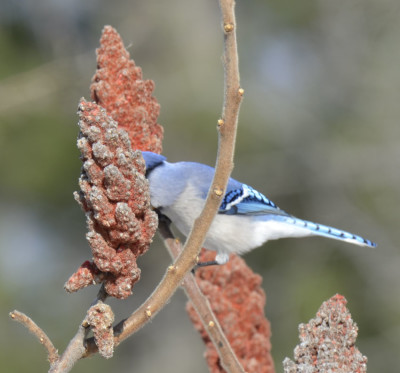
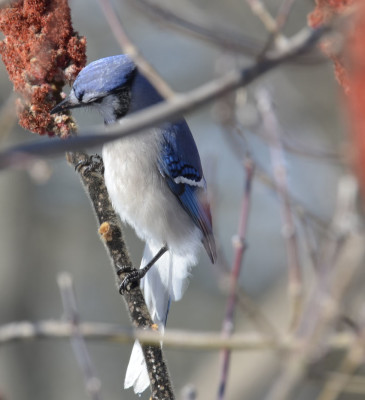
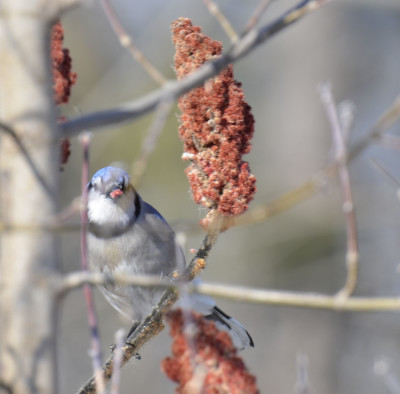
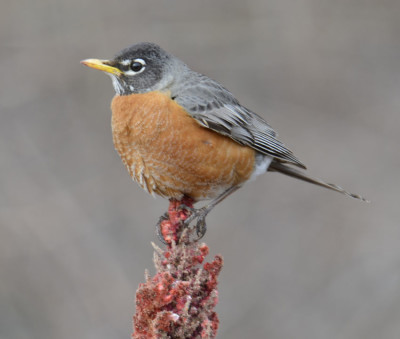
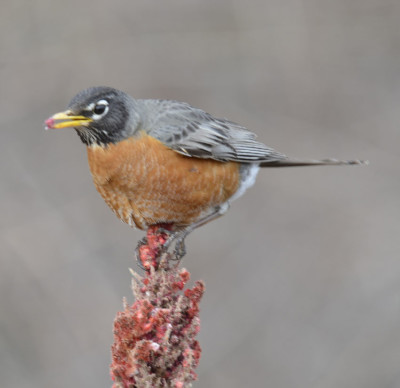

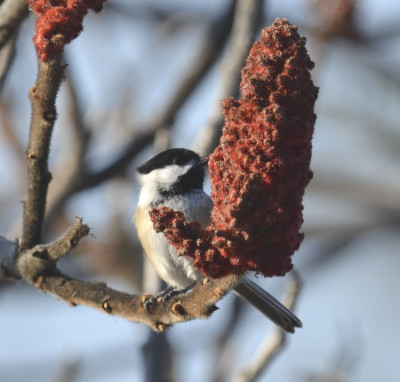
First time on a very cold winter day a flock of grackles attacked an arrangement I had outside for winter with sumac,was very surprised.
Wow, they must have been hungry! Thanks for sharing your interesting sighting!
-23 Celsius out and sunny. We have robins fighting for the sumac. Part of a flock of about 50 .Only one robin goes to the feeder.
Cardinals chase away others at the feeder but leaves junkos and sparrows alone. Nuthatches and chickadees always around feeder as well as woodpeckers.
Guest visits from blue jays and starlings.
Squirrels on the ground eating spillage..
If nothing around and you look up you will see some type of raptor.
At night the rabbits eat what the squirrels left behind
What a wonderful collection to watch from inside out of that wind chill! Thanks for sharing!